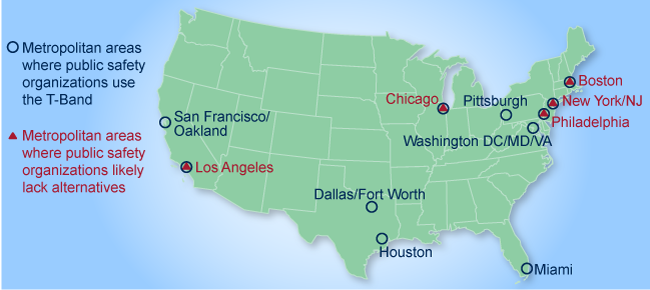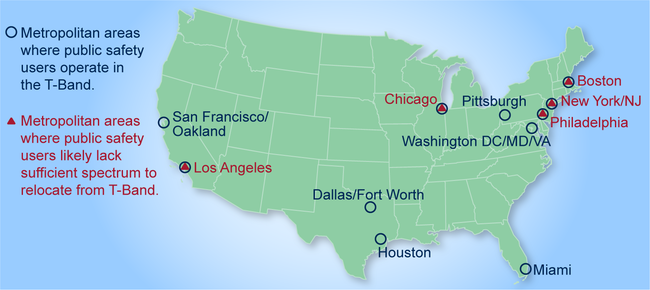July 01, 2019
EMERGENCY COMMUNICATIONS:
Required Auction of Public Safety Spectrum Could Harm First Responder Capabilities
GAO-19-508: Published: Jun 21, 2019. Publicly Released: Jun 21, 2019.
Required Auction of Public Safety Spectrum Could Harm First Responder Capabilities
GAO-19-508: Published: Jun 21, 2019. Publicly Released: Jun 21, 2019.
In 11 large metropolitan areas, critical communications for police, firefighters, and others take place in the T-Band part of the radio spectrum. For example, the NYPD dispatches 911 calls via the T-Band. Starting in 2021, public safety T-Band will be auctioned as required by law. Public safety organizations must move their communications to another part of the spectrum within 2 years of the auction's end. In 3 of the 4 metropolitan areas we examined, officials said they haven't found a T-Band alternative. A recent FCC study also found few options. We recommended Congress consider allowing public safety organizations to keep using the T-Band.
Metropolitan Areas Using T-Band Spectrum for Public Safety and Availability of Alternative Spectrum Options

Sources: GAO analysis of Federal Communications Commission (FCC) and public safety stakeholder data. | GAO-19-508
What GAO Found
Public safety officials, such as police and fire fighters, in 11 metropolitan areas rely on radio systems that use the portion of spectrum known as the T-Band for mission critical voice communications. Selected stakeholders GAO interviewed, including first responders and officials in three of four areas selected as case studies, anticipate significant challenges in relocating public safety communications from the T-Band. For example, stakeholders in Boston, Los Angeles, and New York said the Federal Communications Commission (FCC) has not identified sufficient alternative spectrum. Additionally, two studies conducted by a public safety organization concluded these three areas and others may also have insufficient alternative spectrum (see figure below). Moreover, a recent FCC analysis showed that relocation options for public safety users are limited or nonexistent. Further, costs for relocating public safety users from the T-Band were calculated by FCC to be $5-to-$6 billion. Selected stakeholders said relocating their communication systems would require such things as new towers and radios as well as other infrastructure.
Metropolitan Areas Using T-Band Spectrum (470 to 512 megahertz) for Public Safety and Availability of Alternative Spectrum Options

Sources: GAO analysis of Federal Communications Commission (FCC) and public safety stakeholder data. | GAO-19-508
FCC has taken limited actions to address challenges and assist public safety users of the T-Band with the mandatory relocation. For example, FCC has taken steps to notify stakeholders, but officials told GAO they have not begun planning the auction. FCC officials acknowledged challenges the auction and relocation requirements present. FCC officials explained that public safety entities were licensed to operate on the T-Band in large metropolitan areas because other public safety spectrum was already heavily used. In March 2019, FCC briefed Congress on the auction's challenges and concluded that all T-Band auction scenarios would fail. Nonetheless, FCC officials said the agency will conduct the auction unless the law is amended. While FCC provided information to Congress, it did not suggest changes to law in this instance. Stakeholders in two metropolitan areas said the auction could result in substantial harmful effects on their ability to maintain continuous and effective communications during an emergency.
Why GAO Did This Study
First responders and others in 11 large metropolitan areas use radio systems operating in the T-Band since spectrum is limited in other bands. In 2012, FCC was required by statute to begin an auction of this T-Band public safety spectrum by February 2021 and to make the proceeds available to the National Telecommunications and Information Administration (NTIA) to develop and administer a grant program to help cover costs associated with relocating public safety users' radio systems.
GAO was asked to review issues related to the required T-Band auction. This report examines, among other things: (1) the challenges selected first responders and local governments anticipate facing in relocating public safety communications from the T-Band and (2) the actions FCC has taken both to help facilitate the required T-Band relocation and to address identified challenges. GAO reviewed FCC's March 2019 congressional briefing and analysis on T-Band spectrum and conducted case studies in four cities selected based on the number of public safety licenses in each area, among other things. GAO reviewed relevant statutes and regulations, FCC documents, and T-Band studies conducted by a public safety organization. GAO interviewed FCC officials and other stakeholders, including first responders in case study cities.
What GAO Recommends
Congress should consider legislation allowing public safety users continued use of the T-Band spectrum.
For more information, contact Mark Goldstein at (202) 512-2834 or goldsteinM@gao.gov.
Support Letters




